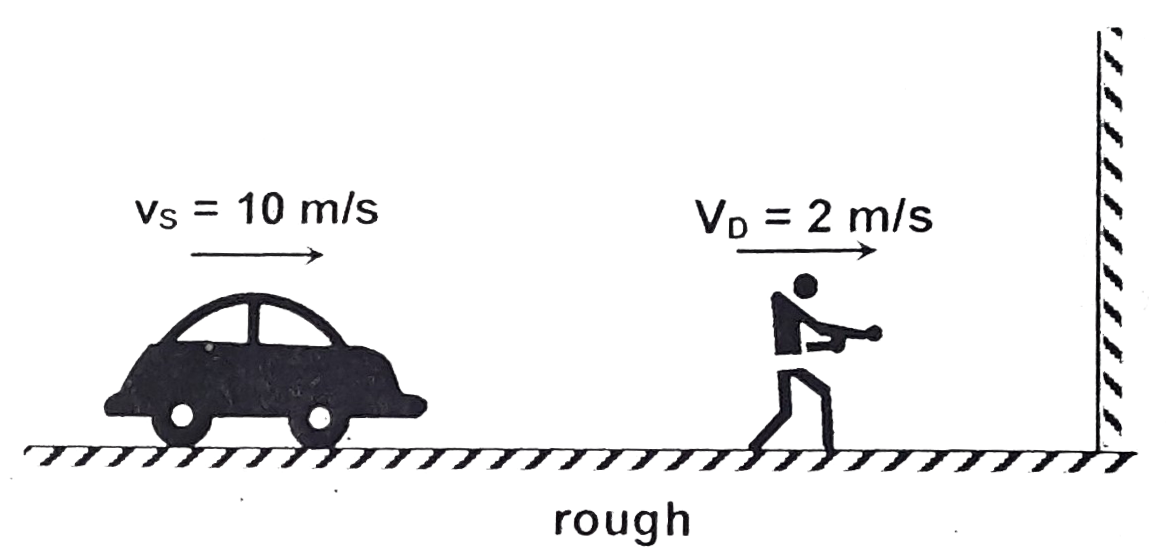Two cars A and B are moving away from each other in opposite directions. Both the cars are moving with a speed of 20ms−1 with respect to the ground. If an observer in car A detects a frequency 2000 Hz of the sound coming from car B, what is the natural frequency of the sound source in car B? (Speed of sound in air =340ms−1)
2250 Hz
2060 Hz
2300 Hz
2150 Hz
The correct Answer is:A
To solve the problem, we will use the Doppler effect formula for sound. The Doppler effect describes how the frequency of a wave changes for an observer moving relative to the source of the wave.
1. Identify the Known Values:
- Speed of sound in air, V=340m/s
- Speed of car A (observer), Vo=20m/s
- Speed of car B (source), Vs=20m/s
- Observed frequency, f=2000Hz
2. Doppler Effect Formula:
The formula for the observed frequency when both the source and observer are moving away from each other is given by:
f=f0(V−VoV+Vs)
where:
- f0 is the natural frequency of the source (what we need to find),
- V is the speed of sound,
- Vo is the speed of the observer (moving away),
- Vs is the speed of the source (also moving away).
3. Substituting the Known Values:
Substitute the known values into the formula:
2000=f0(340−20340+20)
4. Simplifying the Equation:
Calculate the terms inside the parentheses:
340−20=320and340+20=360
Thus, the equation becomes:
2000=f0(320360)
5. Solving for f0:
Rearranging the equation to isolate f0:
f0=2000×360320
6. Calculating the Value:
Simplifying the fraction:
360320=98
Therefore:
f0=2000×98=2000×1.125=2250Hz
Final Answer:
The natural frequency of the sound source in car B is f0=2250Hz.
---
- Speed of sound in air, V=340m/s
- Speed of car A (observer), Vo=20m/s
- Speed of car B (source), Vs=20m/s
- Observed frequency, f=2000Hz
The formula for the observed frequency when both the source and observer are moving away from each other is given by:
f=f0(V−VoV+Vs)
where:
- f0 is the natural frequency of the source (what we need to find),
- V is the speed of sound,
- Vo is the speed of the observer (moving away),
- Vs is the speed of the source (also moving away).
Substitute the known values into the formula:
2000=f0(340−20340+20)
Calculate the terms inside the parentheses:
340−20=320and340+20=360
Thus, the equation becomes:
2000=f0(320360)
Rearranging the equation to isolate f0:
f0=2000×360320
Simplifying the fraction:
360320=98
Therefore:
f0=2000×98=2000×1.125=2250Hz
The natural frequency of the sound source in car B is f0=2250Hz.
Topper's Solved these Questions
Similar Questions
A source and a detector move away from each other, each with a speed of 10ms−1 with respect to the ground with no wind. If the detector detects a frequency 1950 Hz of the sound coming from the source, what is the original frequency of the source? Speed of sound in air =340ms−1.
View SolutionA source and a detector move away from each other, each with a speed of 10 m/s with respect to ground with no wind. If the detector detects a frequency 1650 Hz of the sound coming from the source, what is the original frequency of the source? (speed of sound = 340 m/s
View Solution
Knowledge Check
A train moving at a speed of 220ms−1 towards a stationary object emits a sound of frequency 1000 Hz. Some of the sound reaching the object gets reflected back to the train as echo. The frequency of the echo as detected by the driver of the train is (speed of sound in air is 330ms−1)
A3500 HzB4000 HzC5000 HzD3000 Hz
Two cars A and B are moving towards each other with samne speed 25 m/s. wind is blowing with speed 5 m/s in the direction of motion of car A. The car A blows horn of frequency 300 Hz and the sound is reflected from car B. the wavelength of te reflected sound received by the driver of car A is (velocity of sound in air =330m/s)
View SolutionA train moving at a speed of 220ms−1 towards a stationary object emits a sound of frequency 1000 Hz. Some of the sound reaching the object gets reflected back to the train as echo. The frequency of the echo as detected by the driver of the train is (speed of sound in air is 330ms−1)
View SolutionThe driver of a car travelling with speed 30ms−1 towards a hill sounds a horn of frequency 600 Hz. If the velocity of sound in air is 330ms−1, the frequency of reflected sound as heard by driver is
View SolutionA siren emitting a sound of frequency 2000 Hz moves away from you towards a cliff at a speed of 8 m/s.
(a) What is the frequency of the sound you hear coming directly from the siren.
(b) What is the frequency of sound you hear reflected off the cliff. Speed of sound in air is 330ms.
View SolutionA car is moving with a constant velocity 10m/s towards the stationary wall. The car blows a horn of frequency 320Hz. The velocity of sound in air is 330m/s. The beats frequency received by the observer is

View SolutionA person riding a car moving at 72kmh−1 sounds a whistle emitting a wave of frequency 1250 Hz. What frequency will be heard by another person standing on the road (a) in front of the car (b) behind the car ? Speed of sound in air =340ms−1 .
View SolutionA car is moving with 90kmh−1 blows a horn of 150 Hz, towards a cliff. The frequency of the reflected sound heard by the driver will be (speed of sound in air is 340ms−1 )
View Solution
